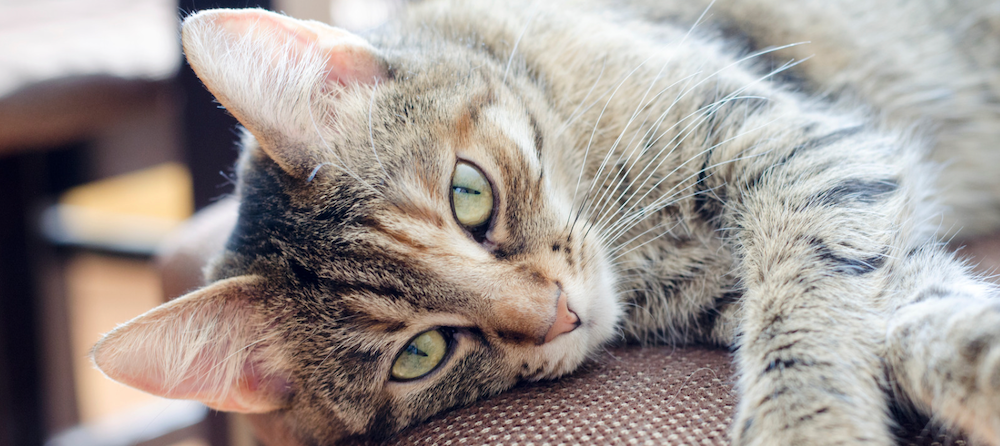If your cat was just diagnosed with diabetes mellitus (DM), don’t despair. In this two-part blog, I’ll explain all you need to know about diabetes in cats.
As an emergency critical care veterinarian, I see a lot of diabetes in cats. That’s because an estimated 1 in every 200 cats is thought to be affected by this endocrine disease (likely due to the growing prevalence of obesity). (1)(2)
So, what does it mean if your cat was recently diagnosed with diabetes? With DM, the body doesn’t produce enough insulin from the pancreas. Insulin is the hormone necessary to push sugar (“glucose”) into the cells of the body to be utilized. Without insulin, the body (and all the cells) are starving for sugar, as the sugar can’t get into the cells. The body is stimulated to produce more and more glucose in an attempt to feed the cells, leading to a hyperglycemia (or elevated blood sugar). This ends up resulting in a lot of the clinical symptoms of diabetes, and ultimately can be fatal without treatment.
Two types of diabetes in cats
Veterinary medicine sees two types of diabetes mellitus.
Type I DM
Type I DM, which is most commonly seen in dogs, occurs when the body fails to produce insulin (a hormone that is normally produced in the pancreas and that regulates blood sugar). This type requires life-long insulin therapy delivered via a syringe twice per day.
Type II DM
Type II DM, which is most commonly seen in cats, occurs when the body produces some insulin but in inadequate amounts (that’s why you need to give more insulin with a syringe). Likewise, Type II DM occurs when something is interfering with the body’s ability to use insulin (for example, due to insulin-resistance from obesity). With Type II DM, diabetes can be transient (e.g., months), and may not require life-long insulin therapy. The more aggressive you try to treat your cat’s insulin (in conjunction with weight loss, follow-up with your veterinarian, blood sugar monitoring, etc.), the better the likelihood that your cat’s diabetes could potentially go away (what we call “going into remission”).
The excess sugar that is produced by the body results in the clinical signs seen with DM. Untreated—or unregulated, meaning the blood sugar isn’t controlled well—this results in electrolyte abnormalities, fatty changes to the liver, cataracts in the eyes (mostly in dogs), peripheral neuropathy (abnormalities in the nerves, making cats walk “down in their hocks”), and a predisposition to urinary tract infections.
Which cats are at risk?
We most frequently see DM (meaning it is over-represented) in the Siamese, male cats, and older cats—typically 8-13 years of age.
Symptoms of diabetes in cats
Make sure you recognize the early signs of diabetes mellitus. This is important because the sooner we recognize the signs, the sooner we can identify and treat diabetes, and the less expensive and dangerous it will be for your cat!
Symptoms include:
- Weakness
- Lethargy
- Excessive thirst (or filling the water bowl more often)
- Drinking out of unusual places (such as the bathroom sink or toilet)
- Excessive urination (clumps in the litter box bigger than your clenched fist!)
- Poor skin condition (like excessive dandruff or an oily hair coat)
- Inappropriate urination
- Dilute urine
- Weight loss (most commonly over the back), despite an overweight body condition
- Increased hunger
- Obesity but still feeling “boney” and muscle-wasted
- Walking “down in the hocks” (what we vets called plantigrade with a very flat angle to the back legs)
- Sweet “acetone” breath when in diabetic crisis
How do we diagnose diabetes in cats?
The diagnosis of diabetes mellitus is based on physical examination findings and blood work changes commonly seen with the disease.
Recommended tests include:
- A complete blood count (CBC) to look at the red blood cell count (looking for dehydration or anemia) and white blood cell count (looking for underlying infection)
- A chemistry panel to evaluate how high (or low) the blood glucose is and look at the kidneys, liver, electrolytes, protein, and other bodily functions. Normal blood glucose in a cat ranges from approximately 80-150 mg/dL, but when cats are stressed (by going for a car ride, seeing the cat carrier, etc.), they get a temporary increase in their blood sugar (called a “stress hyperglycemia”). This means their blood sugar can spike up to 200 or even 300 mg/dL in severe cases! Persistent, repeated elevations in the blood sugar are consistent with diabetes mellitus in cats
- A urinalysis (UA) to look for the presence of sugar spilling over into the kidneys and bladder, supportive of DM. Normally, there shouldn’t be any sugar in the urine
- A urine culture to rule out a urinary tract infection
- A serum fructosamine blood level, which looks at the effect of blood sugar on the body’s protein levels and gives us a general idea of how well the blood sugar is regulated
- X-rays of the chest and abdomen to rule out underlying medical problems like cancer, pneumonia, bladder stones, etc.
- An ultrasound of the abdomen to look at the architecture of the organs (like the pancreas), to rule out metabolic problems, fatty changes to the liver, cancer, etc.
In next month’s blog, I’ll talk about how we treat and prevent diabetes in cats.
Is your cat diabetic? What signs did you notice and how is your cat responding to therapy?
References
- Greco D. Diabetes mellitus without complication – Cats. In Blackwell’s Five-Minute Veterinary Consult: Canine & Feline. Eds. Tilley LP, Smith FWK. 2007, 4th ed. Blackwell Publishing, Ames, Iowa. pp. 374-375.
- Webb C. Diabetes mellitus without complication – Dogs. In Blackwell’s Five-Minute Veterinary Consult: Canine & Feline. Eds. Tilley LP, Smith FWK. 2007, 4th ed. Blackwell Publishing, Ames, Iowa. pp. 376-377.
Recommendations









